How
many ripoffs of Seven Samurai
can there be? Thereís The
Magnificent Seven, which spawned sequels and a TV series (which
I have, merciful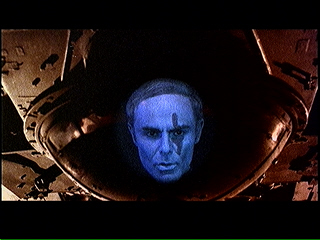 ly, never seen), thereís episodes of Star Trek: Deep Space Nine and Kung
Fu: The Legend Continues, there was even a brief, two-issue
storyline early in the Marvel Comics run of Star
Wars that had Han Solo and Chewie recruiting spacers on some
backwater world to fight some bandits riding air motorcycles.
And then there was Battle
Beyond the Stars.
ly, never seen), thereís episodes of Star Trek: Deep Space Nine and Kung
Fu: The Legend Continues, there was even a brief, two-issue
storyline early in the Marvel Comics run of Star
Wars that had Han Solo and Chewie recruiting spacers on some
backwater world to fight some bandits riding air motorcycles.
And then there was Battle
Beyond the Stars.
Donít
get me wrong, Battle Beyond
the Stars (or BBTS,
for brevity) (I know, I know, brevity should be a foreign concept to
me) is a fun little movie, and it allowed many fine actors to pay
their rent that month. It
also generated spaceship footage that Roger Corman is still
recycling and re-cutting into any production he can.
But itís hard to really call it ďqualityĒ
entertainment, in the same way that some of its precursors can be so
named. It canít escape
its essential cheapness, which is always the hobgoblin of little
Corman films. It tries
to compensate with originality, and almost succeeds, but in the end,
itís a cheap attempt to exploit the popularity of Star
Wars in a time-honored ensemble format.
In that, itís hardly a singular film.
It
is, however, a veritable buffet of famous faces.
In compiling the research for this particular film, I
discovered some of the hardest working actors in show business,
based on the number of productions and TV guest appearances listed
on the IMDB. Take a look
at this table of the main actors:
|
Actor
(Role)
|
Productions
|
Guest
Spots
|
|
Richard
Thomas (Shad)
|
72
|
21
|
|
Robert
Vaughn (Gelt)
|
128
|
97
|
|
John
Saxon (Sador)
|
125
|
77
|
|
George
Peppard (Cowboy)
|
45
|
14
|
|
Darlanne
Fluegel (Nanelia)
|
25
|
4
|
|
Sybil
Danning (Saint-Exmin)
|
59
|
9
|
|
Sam
Jaffe (Dr. Hephaestus)
|
36
|
35
|
|
Jeff
Corey (Zed)
|
139
|
71
|
|
Morgan
Woodward (Cayman of the Lambda Zone)
|
42
|
134
|
|
Marta
Kristen (Lux)
|
13
|
22
|
|
Earl
Boen (Nestor 1)
|
114
|
107
|
|
Lynn
Carlin (Nellís Voice)
|
24
|
30
|
|
|
|
|
|
AVERAGES
|
68.5
|
51.75
|
Now,
even just by the numbers, thatís a lot of star power!
And thatís just in front of the camera.
The director, Jimmy T. Murakami, also did Humanoids from the Deep, for what itís worth.
Okay, thatís not a good example. 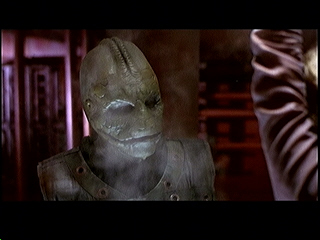 But one of the screenwriters was John Sayles, who has done 28
other major films, including The Brother From Another Planet, Lone Star, and, of course, Piranha!
It was produced by the (in)famous Roger Corman, as one of his
first 150 projects (heís up to 342, now), and it featured starship
models created by none other than Titanicís
James Cameron. The score
was composed by James Horner, who provided the excellent music in Krull, several Star Trek
films, and most of the Land
Before Time movies. Mind
you, it all starts to sound reminiscent of each other, but thatís
okay, because it rather sets the scene, doesnít it?
I mean, it still provides the right quasi-martial
action-movie mood, so I think it works.
But one of the screenwriters was John Sayles, who has done 28
other major films, including The Brother From Another Planet, Lone Star, and, of course, Piranha!
It was produced by the (in)famous Roger Corman, as one of his
first 150 projects (heís up to 342, now), and it featured starship
models created by none other than Titanicís
James Cameron. The score
was composed by James Horner, who provided the excellent music in Krull, several Star Trek
films, and most of the Land
Before Time movies. Mind
you, it all starts to sound reminiscent of each other, but thatís
okay, because it rather sets the scene, doesnít it?
I mean, it still provides the right quasi-martial
action-movie mood, so I think it works.
So
many of the people here had either done, or were on their way to,
great things. Or
mediocre things. Well,
okay, many things of varying quality.
Point is, they were hard-working professionals, all pulling
together for what was, no doubt, expected to be a quickie moneymaker
that would fade almost immediately.
Which it did, of course, but it had enough juice and
originalit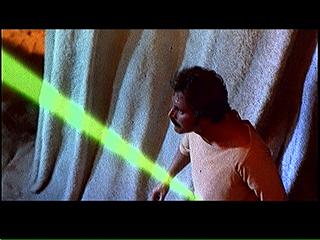 y to linger in the minds of people such as us, and
thatís why itís so interesting to see these days (as opposed to Carnosaur, for example)
y to linger in the minds of people such as us, and
thatís why itís so interesting to see these days (as opposed to Carnosaur, for example)
Richard
Thomas is, of course, famous for playing John Boy on The
Waltons for a whole bunch of years.
He is playing, appropriately enough, a space farmer named
John Boy. No, actually,
the characterís name is Shad, but as Mr. Thomas has been so
thoroughly identified with the character of John Boy Walton, itís
hard not to think of that name when you see him.
John
Boy is a dreamer, the only young man on his peaceful, bucolic home
planetoid of Akir (represented by an obvious matte painting and a
few bulbous buildings) who still looks fondly upon the adventuresome
stories of the communityís only other rebellious type, the aged,
blind, former space pirate, Zed (the late Jeff Corey, an old Western
mainstay, and also the Grand Vizier in Conan
the Destroyer). Thatís
why, when the planetoid is menaced by the evil Sador (the
always-solid John Saxon, who was in far too many films of this
quality to pick only a few favorites) and Sadorís super-starship
full of deteriorating mutants (the Malmori, though itís more like
the Mal-formed-i), John Boy is the one who has to fly o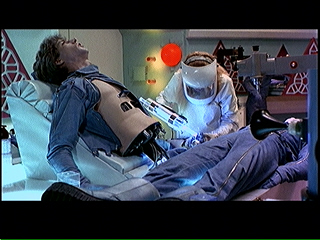 ut on Zedís
old starship, Nell, and get some help before Sador comes back to
take the yearís harvest and whatever slaves he feels a fancy
toward. Mind you,
violence is forbidden by the Varda, the scriptures that the natives
of Akir live by, but when youíve only got seven risings of the
planetís star in which to comply, that motivates a lot of
understanding from Varda scholars.
ut on Zedís
old starship, Nell, and get some help before Sador comes back to
take the yearís harvest and whatever slaves he feels a fancy
toward. Mind you,
violence is forbidden by the Varda, the scriptures that the natives
of Akir live by, but when youíve only got seven risings of the
planetís star in which to comply, that motivates a lot of
understanding from Varda scholars.
Itís
standard to have representatives from the village go out to find
help, just as itís standard for the villagers to eventually arm up
and help defend their own homes.
Whatís not quite so standard is the thorough participation
of the village representative, who eventually becomes as much of a
warrior as any of them. John
Boy is such a central character, not only in the beginning but
throughout the film, that he canít help but become a full
participant in what is to come.
It also saves with having to hire another actor, as John Boy
can be counted as one of the seven.
The
only starship in the film with any personality, Nell (whose computer
voice is provided by Lynn Carlin, who previously worked with John
Boy as a guest star on The
Waltons) is a flying rack. By
that, I mean she has two rounded, roughly co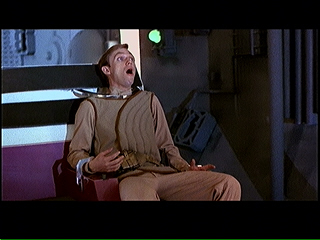 nical projections
jutting out from the bow. Yes,
folks, flying breasts. Whee!
In any case, Nell doesnít think too highly of young John
Boy; heís got a lot to prove, it heís going to live up to
Zedís example.
nical projections
jutting out from the bow. Yes,
folks, flying breasts. Whee!
In any case, Nell doesnít think too highly of young John
Boy; heís got a lot to prove, it heís going to live up to
Zedís example.
Nellís
also a good teacher in the value of practicality over pure theory,
as the movie progresses (ďDamn stupid rule,Ē she says at one
point). In your own
little ivory tower, or whatever metaphor suits your personal
intellectual enclave, itís easy to cling to rigid codes of
behavior and thought, but out in the wild wooliness of reality, your
little preconceived notions may not fit with the needs of survival.
Itís all well and good to believe in the inherent goodness
of all beings (or ďformsĒ as the movie calls them, presumably an
abbreviation of ďlife-formsĒ), but someoneís deeply buried
core of goodness does you no good when youíre faced with the
surrounding layers of brutal evil brandishing a weapon at you.
Verses from whatever scripture you follow may give you a plan
for your life, but they canít cover every conceivable situation,
and sometimes what they tell you is true simply isnít, in the real
world. Itís a sad fact
of life that John Boy has to confront, and Nell makes sure he gets
the point.
Maybe
thatís the point of growing up: youíre supposed to realize the
world is infinitely complex, and your version of truth and goodness
is just one among many. In
an ideal world, people would get to that point, and try to figure
out a way to coexist with other points of view.
In the actual world, however, it seems like many folks see
this truth, then e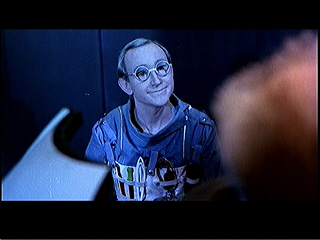 mbark on a campaign to convert all other points of
view to their own. Which,
to my mind, seems not only an impossible task, but one more likely
to incite more than its fair share of stress, discord, and violence.
And even if you succeed, you end up with a dull, monotonous
intellectual landscape, which will fly to pieces as soon as one
person gets a new idea. But
thatís for the philosophy text, not for the movie review.
mbark on a campaign to convert all other points of
view to their own. Which,
to my mind, seems not only an impossible task, but one more likely
to incite more than its fair share of stress, discord, and violence.
And even if you succeed, you end up with a dull, monotonous
intellectual landscape, which will fly to pieces as soon as one
person gets a new idea. But
thatís for the philosophy text, not for the movie review.
It
takes a little bit of evasion to get past the one fighter that Sador
has left behind to watch the planet, but they manage it.
Then itís open space and free-wheeling fun.
Zed gives John Boy one lead: Dr. Hephaestus, an old ally from
back in the day. The
good Dr. is played by Sam Jaffe, who probably couldnít help but
compare this role to his turn as Professor Jacob Barnhardt in The
Day the Earth Stood Still. He
has more charisma in the limited time we get to see him than some of
the leads have in this whole movie.
Thatís professionalism.
Anyway,
Hephaestus lives on an almost-abandoned space station, tended by his
androids, which are, for obvious reasons, completely human-like.
He also has a daughter, Nanelia, who, upon meeting John Boy,
attempts to di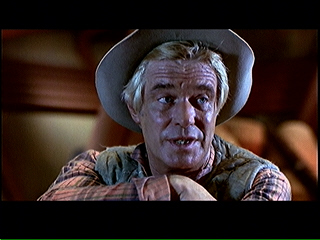 sassemble him. It
turns out John Boy is the first form, other than her father, sheís
ever met. Which is easy
to say, but what kind of personality would that produce?
Particularly when her father is willing to lock down the
Space-Breasts and keep John Boy prisoner for breeding purposes.
With his daughter, naturally; apparently their forms are
genetically compatible. Frankly,
it seems like most ďformsĒ are pretty simplistic; there was not
much of an effort put forth to make the aliens actually alien, but
thatís okay. Thatís
not why weíre here, anyway.
sassemble him. It
turns out John Boy is the first form, other than her father, sheís
ever met. Which is easy
to say, but what kind of personality would that produce?
Particularly when her father is willing to lock down the
Space-Breasts and keep John Boy prisoner for breeding purposes.
With his daughter, naturally; apparently their forms are
genetically compatible. Frankly,
it seems like most ďformsĒ are pretty simplistic; there was not
much of an effort put forth to make the aliens actually alien, but
thatís okay. Thatís
not why weíre here, anyway.
Defying
all sense and logic, Nanelia decides to release John Boy.
Despite growing up the way she did, and using an android
torso as some kind of boom-box, of all things, she somehow still has
a desire to see the universe. Somehow,
her spirit has not been crushed by her oppressive living standards.
Which is, of course, the real science fiction here.
But I digress. She
and John Boy flee her father, though she canít bring anything
better than a high-tech Game-boyô, and then split up in order to
find warriors to help John Boyís planet.
Technically, Nanelia is just supposed to meet him in the
Lambda Zone, but we all know how that sort of thing turns out,
donít we?
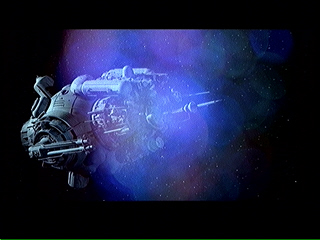
Then
we meet the Space Cowboy (George Peppard, also known as The A-Teamís Hannibal Smith) in his space machine, as heís under
attack by ďjackers.Ē Heís
a long-distance cargo hauler from Earth with an unhealthy
fascination with the Ancient West, and some call him the doctor of
love (if they donít call him Maurice).
This places the story firmly in the future, in our galaxy,
whereas avoiding any mention of our planet would have left the whole
thing open. Anyway, they
wanted a cigar-smoking, whiskey-drinking realist, who happened to
have on hand a bunch of weapons (seems his clients get themselves
all blowed up by Sador, which not only demonstrates his weapon, but
also provides arms for an unarmed planetó10,000 laser Mac-10s, and
40,000 charge slots). In
order to unload his otherwise profitless cargo, he agrees to go to
John Boyís planet and help train the people to defend themselves.
Who do you want to bet is going to find a cause to care
about? Or at the very
least, heís going to have a plan he loves when it comes together.
At
this stage, I should point out Morgan Woodward in his role as Cayman
of the Lambda Zone, last survivor of his species, the Lazuli, thanks
to Sador. Woodward
played Boss Godfrey in Cool
Hand Luke, and had some guest roles on X-Files
and Millenniu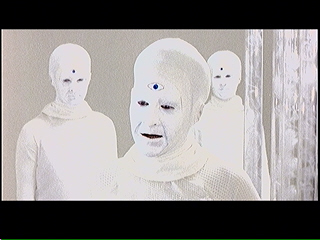 m, but
youíll never recognize him under all the Cayman makeup.
One of Caymanís significant points is that not only does he
provide one of the seven starships, but he travels with assistants,
a big burly guy with a pole-arm (Kophim?
Coophim?) and two members of the Kelvin species, who radiate
intense heat. Thereís
a fun little moment, later in the film, when the Kelvins are sitting
back to back, with everyone else circled around them, and Cowboy is
roasting hot-dogs near them. Everyone
makes a contribution to the fight, which is properly heroic of them,
even if the main motivation is revenge.
m, but
youíll never recognize him under all the Cayman makeup.
One of Caymanís significant points is that not only does he
provide one of the seven starships, but he travels with assistants,
a big burly guy with a pole-arm (Kophim?
Coophim?) and two members of the Kelvin species, who radiate
intense heat. Thereís
a fun little moment, later in the film, when the Kelvins are sitting
back to back, with everyone else circled around them, and Cowboy is
roasting hot-dogs near them. Everyone
makes a contribution to the fight, which is properly heroic of them,
even if the main motivation is revenge.
Possibly
the lightest of the mercenary characters is Nestor, a group-mind
being with a number of humanoid bodies, who joins for the sheer
adventure of it. The
primary interface of Nestor is played by Earl Boen, who is much more
recognizable as the psychologist Dr. Peter Silberman, who makes
appearances in the various Terminator movies. For
one thing, heís not under quite so much white pancake makeup in
any of those films as he has to play under here in BBTS.
Or maybe his face is naturally pasty white, and they have to
doctor him up for his non-Nestor film roles.
That might explain why he does so much voice-only work,
particularly for videogames. Then
again, maybe itís just easy money.
I
can only imagine that a modern remake would simply use CGI to map
the same face, or even body, onto all Nestor.
They could even make that third eye blink, once in a while.
Hey, Corman did what he could with what he had available at
the time, no faulting that, but I could see what he was attempting
to create, and modern technology w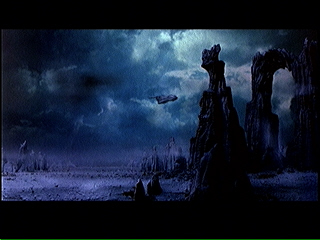 ould simply allow him to create it
even better. Thatís
assuming there would be a remake, which I wouldnít put it past
Hollywood
Ö
ould simply allow him to create it
even better. Thatís
assuming there would be a remake, which I wouldnít put it past
Hollywood
Ö
Now,
to provide a little break between two John Boy scenes, you have to
cut to something else. In
this case, itís a little scene with the two left behind to guard
the planet. I swear one
of them, probably Kalo, is Wallace Shawn (well known as Vizzini from
The Princess Bride)
acting under a pseudonym, but thatís a question for later.
Anyway, they use a transporter to beam up John Boyís
sister, Mol, who is played by Julia Duffy (well known as playing
Stephanie Vanderkellen on The
Bob Newhart Show), for their obscene pleasure.
Mind you, this brings up a question later on, but hey,
thatís for later. You
have to wonder, however, exactly how big these fighters are: they
seem to have a huge control area and a whole suite of back rooms.
Odd, that.
Going
to a wretched hive of scum and villany to look for more recruits
(hey, it worked for Obi-Wan), John Boy finds that the whole place
has gone downhill since the days Zed and Nell knew it.
He has the opportunity to try some vices, but decides against
it. Not counting a
creepy ďdial-a-dateĒ machine, thereís only one resident: the
intensely skilled mercenary Gelt (pronounced like the German word
for ďmoney,Ē appropriately enough), who is played by Robert
Vaughan.

Robert
Vaughan. Itís
difficult to do a Seven
Samurai remake without
Vaughan
. He even had a
recurring role in the Magnificent
Seven TV show; the only reason he wasnít in the DS9
episode was because he was too tall to play a Ferengi (and they kind
of made up for it by casting Iggy Pop in a role, which has nothing
to do with anything else here).
The point is, heís defined the kind of character you need
in one of these films, the professional whoís seen too much, has
too much past, and is therefore too haunted to enjoy what heís
earned. The archetype is
supposed to show how evil and killing can wear on a personís soul,
regardless of wealth, and either you deaden yourself to it (like the
villains) or you suffer for it (like the heroes).
And few people show it quite like Robert Vaughan (largely
because few people have had as much practice at it).
Vaughan
is also one of the hardest-working spies in show business, having
parleyed Napoleon Solo into 12 separate credits on his resume, and
that still counts the 4 years of the Man from U.N.C.L.E. series as one.
In
any case, this ďRobert VaughanĒ kind of character also plays
with one of my favorite concepts: the passage of time and what it
does to a hero. Or
villain, for that matter. When
youíre young and vital and can change the world, what happens
forty years later, when your sequin-studded butt has that middle-age
spread and youíre basically rehashing your former glory before
your appointed date with an aneurysm on the toilet?
I loved it in The Dark
Knight Returns (though not so much in The
Dark Knight Strikes Again), and the idea crops up in everything
from DS9, to Bubba
Ho-Tep, to The Shootist,
to, naturally, most of the Seven
Samurai remakes in existence.
Actually, BBTS is
unusual, in that the impermanence of youth and fame, the sense of
loss and age and acceptance, is dealt with not only through Robert
Vaughan, but also through Zed, the boob-ship, the Cowboy... heck,
even Sador is constantly getting transplanted organs and limbs in an
effort to forestall age and death (a fact which becomes a plot point
later on). Many would
think this leads to a darker, more depressing film; I think it
simply adds a bit of realism and foresight that is missing in most
action/adventure SF.

Anyway.
Gelt settles disputes. Very
quickly. Heís very
good at it. And he
doesnít care who he works with.
John
Boy has a bit of trouble with this.
ďYou kill for money?Ē
ďI
have no home, no family, no principlesÖ what else would I kill
for?Ē
ďPleasure?Ē
ďNo.
Itís strictly business with me.Ē
This is pretty much the only thing that separates him from
Sador and the Malmori. Well,
that, and heís calmer, and actually competent.
And not slowly warping.
Gelt
comes along for the price of a good meal and a place to hide.
Heís quite effective, but they reuse the shots of his
minimalist professionalism, flying his spacecraft, way too much.
A little bit is cool, but after you start to recognize the
flick of the eyes, it gets old.
But hey, itís a Corman film; count the different
explosions, and youíll only take half a dozen drinks, because they
re-use them over and over again.
Itís expected.
Every
group of samurai has to have that one hanger-on, the one who they
really donít want around, but who proves themselves useful and
eventually earns the honor. In
the original Seven, that was Toshiro Mifuneís plum role.
In Magnificent  Seven,
it was Hilario, ďthe kid,Ē played the late Mexican star Jorge
Martinez de Hoyos as the son of a peasant who also carries the love
story (mixing up some of the standard Seven
qualities that seem to appear in most adaptations).
In BBTS, itís
the glamorous Saint-Exmin, member of a warrior race, the Valkyrie (geez,
want to come up with some original names, there?), who must prove
themselves in battle to earn adulthood.
She starts by ďcounting coupĒ on Nell, earning John
Boyís entirely uncharacteristic ire (I mean, really, you need all
the help you can get, including annoying help), and she eventually
just hangs around enough that she becomes part of the group.
Saint-Exmin is played by Sybil Danning at the height of her
lusciousness, well after The Four Musketeers but before Chained
Heat. While itís
always, always good to have a leggy beauty in a silver lame
underpants-based costume, particularly with costume elements that
draw such attention to her ample bosom, Iím not sure how
intimidating it makes her as a combatant.
Of course, the intimidation factor is also offset by the
reclining cleavage-enhancing, spread-legged position of her flight
chair. Pretty as she is,
looking up her nostrils is not as flattering as you might think.
Seven,
it was Hilario, ďthe kid,Ē played the late Mexican star Jorge
Martinez de Hoyos as the son of a peasant who also carries the love
story (mixing up some of the standard Seven
qualities that seem to appear in most adaptations).
In BBTS, itís
the glamorous Saint-Exmin, member of a warrior race, the Valkyrie (geez,
want to come up with some original names, there?), who must prove
themselves in battle to earn adulthood.
She starts by ďcounting coupĒ on Nell, earning John
Boyís entirely uncharacteristic ire (I mean, really, you need all
the help you can get, including annoying help), and she eventually
just hangs around enough that she becomes part of the group.
Saint-Exmin is played by Sybil Danning at the height of her
lusciousness, well after The Four Musketeers but before Chained
Heat. While itís
always, always good to have a leggy beauty in a silver lame
underpants-based costume, particularly with costume elements that
draw such attention to her ample bosom, Iím not sure how
intimidating it makes her as a combatant.
Of course, the intimidation factor is also offset by the
reclining cleavage-enhancing, spread-legged position of her flight
chair. Pretty as she is,
looking up her nostrils is not as flattering as you might think.
Okay,
so, the warriors gather to plan and prepare.
Thereís going to be space battles, but also ground action,
and everybody, including the farmers, has to train and get ready.
Sador takes an inordinately long time to decide to simply
blow up the blasted planet; maybe he thought he could still get the
ďtributeĒ he demanded if he crushed their resistance early on,
but then again, he seemed willing to blow up another planet for
trivial resistance; why wouldnít he do the same here?
But weíre all here for the battle sequences, which are not
too badly done, considering their source.
I mean, sure, we get tired of seeing the same old explosion
every few seconds, but explosions were expensive back then.
So itís more a matter of getting the best value for your
dollar, which Corman has done, considering heís re-used all that
model footage for pretty much every space project heís developed
since 1980. I once owned
a copy of Space Raiders,
and I wondered why all the battle scenes looked so familiarÖ
Thereís
a certain degree of ďwhy the hell did they do that, thatís just
stupid and suicidal,Ē and thereís a couple of points where they
break some of the rules they established early on (not unlike saying
vampires canít stand daylight, then having them walk around in the
afternoon sun), but overall, they manage to keep some tension and
let things move along at a good clip.

Of
course, I wonder why Sador would need to invade on the ground,
anyway. With his huge
ship, with its snipers of proven effectiveness, and heck, even with
a few strafing runs from the fighters, you could do a lot more
damage than those ground forces did, without risking a single mutant
soldier. Also, why did
they have to drop the troops so far away?
The planet doesnít have any ground-based forces, so if
youíre going to get people past the rag-tag army of ships, anyway,
you might as well put down right in the central square, forget all
those suspicious-looking trenches.
And youíve already demonstrated that you have transporters,
so why do you have to land people, anyway, when you can transport
them wherever you like? Some
muddy planning on Sadorís part, I think.
But I suppose that kind of tactical thinking has no place in
the distant future. Neither
does ergonomic design, as who in their right mind would make a
combat fighter where you had to reach across your body to tap the
one key to fire your weapons? Isnít
that what they build triggers into control sticks for?
Man, I tell you, move one normal person several thousand
years in the future, by movie rules, and youíd absolutely rule!
Hereís
one little thing I noticed while researching the movie.
Besides the folks listed at the start, many of these people
have very few, if any, other credits.
Yago, Sadorís chief lieutenant?
Played by Dick Carlos? No
other credits under that name. The
two mooks left behind in the fighter to guard the planet, Kalo and
Tembo, played by Robert Pearce and Larry Broyles?
Only Robert has a previous credit (one), and neither ever
worked again. The two
actors credited as the characters both named Pez, Daniel Carlin and
Doug Carlsson? No other
credits. Wok as played
by Ansley Carlson (not to be confused with Wok as played by Galen
Thompson, a real actor and writer)óonly credit, just like Quopeg
as played by Steve Says (again, not to be confused with Quepeg
played by Steve Davis, another real actor).
Thereís the actress Kimberly Sommer, playing Kintwarna, and
Dallas Clarke, playing Askew, who only have this as their credit,
and I donít even  remember those characters appearing in the
finished film.
remember those characters appearing in the
finished film.
Hereís
another thing: in the quotes on the IMDB, they list Sador as
introducing his third officer, Frojo (though, when watching the
film, I thought it sounded like Dokko, and I donít remember the
third officer so much as surgeon).
However, in the complete credits, thereís no such name,
Frojo or Dokko. Weird.
Thereís
one notable actor that I havenít mentioned yet, in the stellar
role as Garóone Terrence E. McNally, who not only co-wrote the
Julie Brown song ďHomecoming Queenís Got A GunĒ with Charlie
Coffey, but also co-wrote (with Coffey), produced, and played a role
in Earth Girls Are Easy, which had Julie Brown in a prominent
supporting role. Julie
was his wife, at the time, though that has since ended.
Anyway.
All in all, itís pretty dated and cheesy, but itís fun,
and thereís a whole lot worse out there, particularly from Sayles
and Corman. A lot of
these people turn in excellent performances for no discernable
reason. If youíre a
film buff, you can spend a lot of time comparing and contrasting
different versions of the story.
And itís much shorter than the original Kurosawa film.

Thereís
something to be said about having a giant holographic John Saxon
head address the crowd. I
mean, if youíre going to intimidate a large group of people, I
think John Saxon might work as well as anyone else.
Except maybe Ming the Mercilessís head; thatís about all
I can think of to top it.
Rule
of Science Fiction: Never trust any strange remote-controlled sleds.
Works for BBTS, also for Disneyís The Black Hole.
Word to the wise.
Thereís
an exchange with quasi-lesbian overtones between Nanelia and Saint-Exmin,
which just seems tacked on, much like the love-story between Nanelia
and John Boy. Will they
never learn? If a love
story isnít integral to the development of the characters, donít
bother with it! I know
thereís a perceived need for it, but perception is not reality.
On the other hand, itís hard to argue with quasi-lesbian
overtones, which is why theyíre so popular even today (witness the
Erotic Tai-Chiô sequence in the second half of the Mutant X
pilot).
I
love Space Cowboyís belt-bar.
Not the most variety in drinks, but if you know what you
like, more power to you.
I
also love the campfire sequence.
Itís small, itís entirely character-driven, and it has
just about nothing to do with the overall plot besides letting you
get to know the participants. Thatís
why I love it.
Though
itís not particularly funny, I do enjoy the scene between Gelt and
the children, when they ask if heís a bad man (with Vaughn taking
the Charles Bronson moment for himself, for a change), is touching
and honest, in its way. Itís
also true in a general philosophical sense, but thatís getting a
bit simplistic.
Caymanís
battle cry:
La-zu-liiiiiiiiiiiiiiiiiiiiiiiiiiiiiiiiiiiiiiiiiiiiiiiiiiiiiiiiiiiiiiiiiiiiiiiiiiiiiiiiiiiiiiiiiiiiiii!
I use that all the time, now, particularly when merging onto
the highway.
-- Copyright 2005, E. M. S. Mitchell(!)

